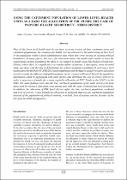| dc.contributor.author | Oryema, Jakor | |
| dc.date.accessioned | 2019-11-08T08:24:47Z | |
| dc.date.available | 2019-11-08T08:24:47Z | |
| dc.date.issued | 2007-08 | |
| dc.identifier.citation | Oryema, J., 2005. Using the catchment population of lower level health units as a basis for allocation of PHC funds: the case of Padyere health subdistrict - Nebbi district. Health Policy and Development, 3(2), pp. 129-143. | en_US |
| dc.identifier.uri | http://hdl.handle.net/20.500.12280/2527 | |
| dc.description.abstract | Most of the lower level health units do not have accurate records of their catchment areas and catchment populations. Yet, resources for health care are allocated to the units basing on their level or the population within a given administrative area which they serve, basing on existing political boundaries. In many places, this basis for allocation leaves the health units unable to meet the requirements of their population. Its effect is very marked in border areas like Padyere Health SubDistrict, where there is a significant cross-border inflow of patients. A descriptive, cross sectional study was done with the aim of determining the actual catchment population of each lower level health unit in the HSD for FY 2002/2003 and comparing it with the figures used for resource allocation in order to study the influence of population figures on the resources allocated. If used, the population information could be aggregated with other factors that determine the cost of service delivery in order to generate a formula for a more equitable allocation of PHC Funds to the LLHUs in the HSD. The main findings were that the true catchment populations of the units varied a lot from those used for resource allocation, even among units with the same workload and level of activity. In addition, the allocation of PHC funds did not reflect the true catchment population, workload and level of activity. A new formula for allocation is proposed, that uses the catchment population (instead of the population of political entities), workload, level of activity and the distance of the HU from the HSD headquarters. | en_US |
| dc.language.iso | en | en_US |
| dc.publisher | Uganda Martyrs University Press | en_US |
| dc.relation.ispartofseries | Health Policy and Development;volume 3 number 2 | |
| dc.subject | Lower level health units | en_US |
| dc.subject | PHC funds | en_US |
| dc.subject | Catchment population | en_US |
| dc.title | Using the catchment population of lower level health units as a basis for allocation of PHC funds: the case of Padyere health subdistrict - Nebbi district | en_US |
| dc.type | Article | en_US |


